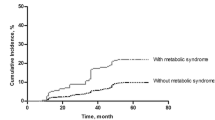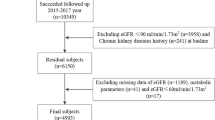Abstract
Background
Obesity is associated with diabetes and hypertension, two major risk factors for chronic kidney disease (CKD). Recently, it has been shown that obesity is associated with preclinical kidney disease defined by elevated levels of cystatin C among those without CKD in US adults. However, the association of obesity with cystatin C is not known in industrialized Asian populations.
Methods
We examined 2,052 Indian adults aged 40–80 years in Singapore who were free of CKD defined as a serum creatinine-based estimated glomerular filtration rate (eGFRcr) <60 mL/min/1.73 m2 and/or the presence of microalbuminuria. Body mass index (BMI) values were categorized into normal (18.5–24.9), overweight (25–29.9) and obese (≥30 kg/m2). Elevated serum cystatin C was defined as cystatin C ≥1 mg/L.
Results
Overweight and obesity were significantly associated with elevated levels of cystatin C after adjusting for potential confounders including diabetes and hypertension and eGFRcr. Compared to those with normal weight, the odds ratio (95 % confidence interval) of elevated cystatin C was 1.49 (1.17–1.88) for overweight and 3.20 (2.33–4.39) for obese. This association was consistently present when BMI was analyzed as a continuous variable and also in subgroups of men, women and in those without diabetes mellitus or hypertension.
Conclusions
Higher BMI levels are associated with preclinical kidney disease in Indian adults aged 40 years and above without CKD.

Similar content being viewed by others
References
Ministry of Health: National health survey. http://www.moh.gov.sg/content/dam/moh_web/Publications/Reports/2011/NHS2010%20-%20low%20res.pdf (2010). Accessed 04 May 2013.
Li PK, Kwan BC, Leung CB, Kwan TH, Wong KM, Lui SL, et al. Prevalence of silent kidney disease in Hong Kong: the screening for Hong Kong asymptomatic renal population and evaluation (SHARE) program. Kidney Int Suppl. 2005;94:S36–40.
Chu NF. Prevalence of obesity in Taiwan. Obes Rev. 2005;6:271–4.
Kim DM, Ahn CW, Nam SY. Prevalence of obesity in Korea. Obes Rev. 2005;6:117–21.
Must A, Spadano J, Coakley EH, Field AE, Colditz G, Dietz WH. The disease burden associated with overweight and obesity. JAMA. 1999;282:1523–9.
Hsu CY, McCulloch CE, Iribarren C, Darbinian J, Go AS. Body mass index and risk for end-stage renal disease. Ann Intern Med. 2006;144:21–8.
Wahba IM, Mak RH. Obesity and obesity-initiated metabolic syndrome: mechanistic links to chronic kidney disease. Clin J Am Soc Nephrol. 2007;2:550–62.
K/DOQI. Clinical practice guidelines for chronic kidney disease evaluation, classification, and stratification. Am J Kidney Dis. 2002;39:S1–266.
Fox CS, Larson MG, Leip EP, Culleton B, Wilson PW, Levy D. Predictors of new-onset kidney disease in a community-based population. JAMA. 2004;291:844–50.
Vupputuri S, Sandler DP. Lifestyle risk factors and chronic kidney disease. Ann Epidemiol. 2003;13:712–20.
Sabanayagam C, Lim SC, Wong TY, Lee J, Shankar A, Tai ES. Ethnic disparities in prevalence and impact of risk factors of chronic kidney disease. Nephrol Dial Transplant. 2010;25:2564–70.
Kuo HW, Tsai SS, Tiao MM, Yang CY. Epidemiological features of CKD in Taiwan. Am J Kidney Dis. 2007;49:46–55.
Zhang L, Zhang P, Wang F, Zuo L, Zhou Y, Shi Y, et al. Prevalence and factors associated with CKD: a population study from Beijing. Am J Kidney Dis. 2008;51:373–84.
Iseki K, Ikemiya Y, Kinjo K, Inoue T, Iseki C, Takishita S. Body mass index and the risk of development of end-stage renal disease in a screened cohort. Kidney Int. 2004;65:1870–6.
Shankar A, Leng C, Chia KS, Koh D, Tai ES, Saw SM, et al. Association between body mass index and chronic kidney disease in men and women: population-based study of Malay adults in Singapore. Nephrol Dial Transplant. 2008;23:1910–8.
Shlipak MG, Praught ML, Sarnak MJ. Update on cystatin C: new insights into the importance of mild kidney dysfunction. Curr Opin Nephrol Hypertens. 2006;15:270–5.
Madero M, Sarnak MJ. Association of cystatin C with adverse outcomes. Curr Opin Nephrol Hypertens. 2009;18:258–63.
Meng L, Yang Y, Qi LT, Wang XJ, Xu GB, Zhang BW. Elevated serum cystatin C is an independent predictor of cardiovascular events in people with relatively normal renal function. J Nephrol. 2012;25:426–30.
Summaries for Patients. Preclinical kidney disease in elderly people. Ann Intern Med. 2006;145:I22.
Muntner P, Winston J, Uribarri J, Mann D, Fox CS. Overweight, obesity, and elevated serum cystatin C levels in adults in the United States. Am J Med. 2008;121:341–8.
Shankar A, Teppala S. Relationship between body mass index and high cystatin levels among US adults. J Clin Hypertens (Greenwich). 2011;13:925–30.
Lavanya R, Jeganathan VS, Zheng Y, Raju P, Cheung N, Tai ES, et al. Methodology of the Singapore Indian Chinese Cohort (SICC) eye study: quantifying ethnic variations in the epidemiology of eye diseases in Asians. Ophthalmic Epidemiol. 2009;16:325–36.
Levey AS, Stevens LA, Schmid CH, Zhang YL, Castro AF III, Feldman HI, et al. A new equation to estimate glomerular filtration rate. Ann Intern Med. 2009;150:604–12.
Obesity: Preventing and Managing the Global Epidemic. Report of a WHO consultation. World Health Organ Tech Rep Ser. 2000;894:i-253.
Coll E, Botey A, Alvarez L, Poch E, Quinto L, Saurina A, et al. Serum cystatin C as a new marker for noninvasive estimation of glomerular filtration rate and as a marker for early renal impairment. Am J Kidney Dis. 2000;36:29–34.
Dharnidharka VR, Kwon C, Stevens G. Serum cystatin C is superior to serum creatinine as a marker of kidney function: a meta-analysis. Am J Kidney Dis. 2002;40:221–6.
Roos JF, Doust J, Tett SE, Kirkpatrick CM. Diagnostic accuracy of cystatin C compared to serum creatinine for the estimation of renal dysfunction in adults and children—a meta-analysis. Clin Biochem. 2007;40:383–91.
Sabanayagam C, Wong TY, Xiao J, Shankar A. Serum cystatin C and prediabetes in non-obese US adults. Eur J Epidemiol. 2013;28:311–6.
Donahue RP, Stranges S, Rejman K, Rafalson LB, Dmochowski J, Trevisan M. Elevated cystatin C concentration and progression to pre-diabetes: the Western New York study. Diabetes Care. 2007;30:1724–9.
Sahakyan K, Lee KE, Shankar A, Klein R. Serum cystatin C and the incidence of type 2 diabetes mellitus. Diabetologia. 2011;54:1335–40.
Ristiniemi N, Lund J, Tertti R, Christensson A, Ilva T, Porela P, et al. Cystatin C as a predictor of all-cause mortality and myocardial infarction in patients with non-ST-elevation acute coronary syndrome. Clin Biochem. 2012;45:535–40.
Shlipak MG, Katz R, Sarnak MJ, Fried LF, Newman AB, Stehman-Breen C, et al. Cystatin C and prognosis for cardiovascular and kidney outcomes in elderly persons without chronic kidney disease. Ann Intern Med. 2006;145:237–46.
Teo BW, Xu H, Wang D, Li J, Sinha AK, Shuter B, et al. Estimating glomerular filtration rates by use of both cystatin C and standardized serum creatinine avoids ethnicity coefficients in Asian patients with chronic kidney disease. Clin Chem. 2012;58:450–7.
Knight EL, Verhave JC, Spiegelman D, Hillege HL, de Zeeuw D, Curhan GC, et al. Factors influencing serum cystatin C levels other than renal function and the impact on renal function measurement. Kidney Int. 2004;65:1416–21.
Shlipak MG. Cystatin C as a marker of glomerular filtration rate in chronic kidney disease: influence of body composition. Nat Clin Pract Nephrol. 2007;3:188–9.
Lee SH, Park SA, Ko SH, Yim HW, Ahn YB, Yoon KH, et al. Insulin resistance and inflammation may have an additional role in the link between cystatin C and cardiovascular disease in type 2 diabetes mellitus patients. Metabolism. 2010;59:241–6.
Zoccali C. Overweight, obesity and metabolic alterations in chronic kidney disease. Prilozi. 2009;30:17–31.
Wiesli P, Schwegler B, Spinas GA, Schmid C. Serum cystatin C is sensitive to small changes in thyroid function. Clin Chim Acta. 2003;338:87–90.
Acknowledgments
This work was supported by the Singapore Ministry of Education, Academic Research Fund tier 1 No T1-2012 Feb-01; National Medical Research Council Grant STaR/0003/2008; Singapore Biomedical Research Grant (BMRC) 08/1/35/19/550; Singapore Ministry of Health’s National Medical Research Council under its Talent Development Scheme NMRC/TA/0008/2012 (CS). Laboratory and data handling was supported by Qi Chun Toh and Hwee Min Loh.
Conflict of interest
The authors have declared that no conflict of interest exists.
Author information
Authors and Affiliations
Corresponding author
About this article
Cite this article
Sabanayagam, C., Wong, T.Y., Liao, J. et al. Body mass index and preclinical kidney disease in Indian adults aged 40 years and above without chronic kidney disease. Clin Exp Nephrol 18, 919–924 (2014). https://doi.org/10.1007/s10157-014-0945-6
Received:
Accepted:
Published:
Issue Date:
DOI: https://doi.org/10.1007/s10157-014-0945-6




